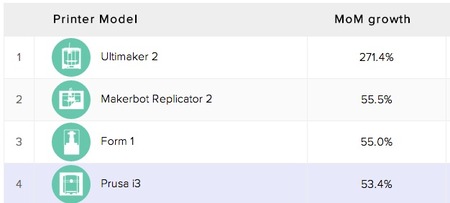3D printer service 3D Hubs knows quite a bit about the state of personal 3D printers because it’s their business. They provide a service where folks with idle 3D printers can accept 3D print work for payment from the public.
By tracking the changes in their population of 3D printer participants, 3D Hubs can observe trends in machine popularity. Currently they manage more than 2300 devices in their network, which we believe to be the largest of any crowd-hub 3D print service.
So what does the report show? The most popular 3D printer is the brand new Ultimaker 2. We suspect there is a slight European bias to the stats as a larger portion of 3D Hubs participants originate from that continent, leading to Ultimaker’s ranking. The new Ultimaker also saw month-over-month growth of an astonishing 271%, but this is likely due to its recent introduction.
After Ultimaker, the list proceeds as follows:
- Ultimaker 2
- MakerBot Replicator 2
- Formlabs Form 1
- RepRap Prusa i3
- Printrbot
- MakerBot Replicator 2X
- PP3DP Up! Mini
- 3D Systems CubeX
- RepRap Generic
- Dimension Generic
The 10th place entrant, Dimension, is the only large-scale commercial unit on the list, suggesting that larger numbers of smaller personal machines now dominate the space.
The list makes sense to us; the major manufacturers who have been selling devices for some time are all on the list, but it’s interesting to see Formlabs in position three, as they’ve been in production for only a year.
While the Ultimaker exhibited a huge growth, all others also showed significant growth, with gains between 32-55%.
Our conclusion: All machines are highly popular, and all manufacturers likely saw significant growth, even those further down the list. It’s a good time to be making 3D printers.
Via 3D Hubs



You say yourself it could be maybe biased by european market at the bottom of the text but the title means it's global market. Pure journalistic marketing effect ( I suspect some dutch friendship here ? )
Anyone looking a little at the source sees it's a pure dutch market ( 90%) as 3dhubs is dutch and ultimaker is dutch (really good by the way).
Just this post is reeeeeally wrong..
You say yourself it could be maybe biased by european market at the bottom of the text but the title means it's global market. Pure journalistic marketing effect ( I suspect some dutch friendship here ? )
Anyone looking a little at the source sees it's a pure dutch market ( 90%) as 3dhubs is dutch and ultimaker is dutch (really good by the way).
Just this post is reeeeeally wrong..
The headline and the source page's methodology looks questionable. They're ranked based on the percentage of growth in, not the total sales in the month. So number of machine A can go from 1 to 2 and get a higher rank than machine B that grew from 10 to 15, even if machine B had a larger net increase.
The headline and the source page's methodology looks questionable. They're ranked based on the percentage of growth in, not the total sales in the month. So number of machine A can go from 1 to 2 and get a higher rank than machine B that grew from 10 to 15, even if machine B had a larger net increase.